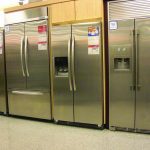By Patrick Keegan and Amy Wheeless

Your refrigerator is probably the most important appliance in your kitchen — choose and place it wisely to save energy.
My family is planning to remodel our kitchen in the coming months. We hope to incorporate energy efficient features to reduce our energy costs. What are some suggestions to increase our kitchen’s efficiency?
Undertaking a remodeling project in any part of your home gives you the chance to make a space work better for your needs—including reducing your energy use. For many households, the kitchen is the heart of the home — meaning it is used the most — so incorporating energy efficiency measures here can have a real impact on your energy bills.
Before starting a remodel, consider having a home energy audit completed by a certified professional. This energy assessment can help you identify major efficiency issues in your kitchen that you can address as you remodel. The audit can also identify other large efficiency investments your home may need that could make sense to invest in at the same time. For example, upgrading your heating and cooling system and ductwork during the same time as your kitchen remodel could be more cost-efficient than completing two separate projects.
Below are some additional tips and thoughts to consider while you go through your kitchen remodel:
Kitchen layout and design
During a remodel, homeowners often want to expand the kitchen. However, bigger isn’t always better — and enlarging the footprint of your kitchen will likely mean higher heating and cooling bills. Consider whether a more efficient layout in your kitchen could prevent a need for expansion.
The design phase of your project is also when you will decide on placement of your major appliances and kitchen features. There may be opportunities to shorten plumbing runs to make hot water delivery to your sink and dishwasher more efficient and to add plumbing insulation to reduce heat loss. Also think about heat sources in your kitchen and how they will affect your refrigerator — placing your refrigerator in a very sunny spot or next to your oven will make this appliance work harder and use more energy.
Appliances
If you are replacing any kitchen appliances, look for ENERGY STAR-certified refrigerators, dishwashers and freezers to help save energy. In particular, refrigerators that are ENERGY STAR-certified will use about 10 percent less energy than standard models — and up to 40 percent less energy than a refrigerator from 2001. Once it is replaced, rather than moving your old refrigerator into the garage where it could use even more energy, ask your electric co-op how you can recycle it. They may even offer a program that hauls away your older appliance.
Lighting
Many remodeled kitchens incorporate lots of windows to ensure a bright, naturally-lit kitchen. Using natural light can make your kitchen feel more open and reduce reliance on overhead lights, but beware of overheating the room in the summer. When thinking about your windows and lighting, consider your home’s climate and orientation and how to use natural light strategically.
In addition to overall lighting, a kitchen needs bright task lighting. Installing individual task lights on separate switches can help minimize the energy you use for lighting. Throughout your kitchen, install ENERGY STAR light fixtures and bulbs, which are certified for energy savings, high quality and performance.
Kitchen ventilation
Increasingly, homeowners are installing professional-looking hoods above stoves in their remodeled kitchens. Be sure to pick a high-efficiency model sized for your needs and install it so that it vents directly to the outside. Remember that running a hood exhaust fan more frequently than needed can make your heating and cooling system work harder, as conditioned air is pulled outside.
Overall comfort
The kitchen is often a family’s gathering place, so installing zonal heat in this space could make sense — you could turn up the thermostat for the kitchen without warming the entire home.
Other ways to ensure that the kitchen is a comfortable room for your family are to address any building envelope issues noted in your energy audit: for example, increase wall and attic insulation, address duct and air sealing needs, invest in efficient windows and install window coverings that help block hot summer sun and blustery winter wind.
Patrick Keegan writes on consumer and cooperative affairs for the National Rural Electric Cooperative Association, service arm of the nation’s 900-plus consumer-owned, not-for-profit electric cooperatives based in Arlington, Virginia. Amy Wheeless writes for Collaborative Efficiency. For more information, visit:www.collaborativeefficiency.com/energytips or email Pat Keegan at energytips@collaborativeefficiency.com.



